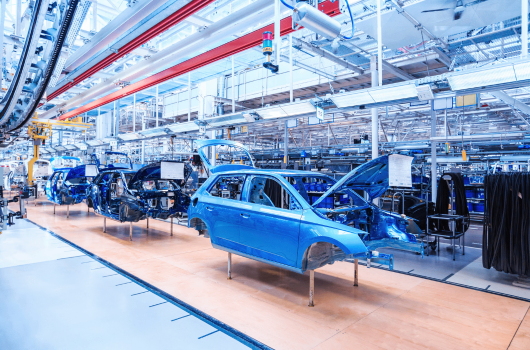Czech industry grew by 0.7 percent in February
Economic commentary by Jakub Seidler, Chief Economist of the CBA

Industrial production surprised slightly positively in February, rising by 0.7% year-on-year, while the consensus of analysts, according to Reuters, expected a slight decline of 0.3%. On the other hand, January's figures were revised downwards and the industry contracted by 0.4% the previous month compared to the initial stagnation (Chart 1). The most significant contributor to growth was car production, which rose by 9% year-on-year. New orders were also optimistic, accelerating not only year-on-year but also month-on-month. Together with the more upbeat leading indicator readings and the improvement in Germany's industry, the latest figures bring a slight optimism about the future development. For the full year 2023, the industry declined by 0.8% (after revision); for this year, the economists' consensus expects industry growth of around 1.5%.
On a month-on-month basis (seasonally adjusted), the industry grew by a strong 1.9% in February while it declined by 2.8% in January. The automotive sector was the strongest contributor to growth, with manufacturing adding over 6% month-on-month, but the production of other transport equipment, computers and building materials also performed well. In contrast, machinery production declined for the second month in a row. However, growth in most industries was above its 3-month average, with the exception of, for example, electricity generation, where the warmer winter had an impact.
In year-on-year terms, the industry grew by 0.7%, but this is a calendar-adjusted figure; unadjusted, growth was 1.5%. The most significant contribution to growth was again made by car production (1.7 pp), which grew by 9% year-on-year (Chart 2). In the opposite direction, machinery and equipment manufacturing and electricity generation made a negative contribution of around 1 pp.New orders were a pleasant surprise in February, adding 5% month-on-month and growing at an annual rate of 9%. The momentum was largely driven by car manufacturing, where orders rose by 25% year-on-year. Although partly due to a low comparative base, the month-on-month increase in foreign orders in the automotive sector was over 10% (Chart 3).
The February industrial readings are thus broadly positive and, in combination with the better-sounding leading indicators, suggest a cautious turn for the better in so far subdued industrial production and foreign demand. Although it is too early to draw more optimistic conclusions from one month's observations, more favourable readings also came from German industry in February, where production noticeably exceeded expectations and grew by 2%, although it remains noticeably down year-on-year (Chart 4).